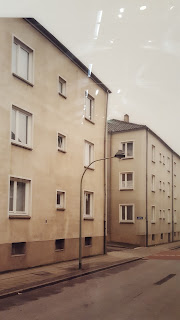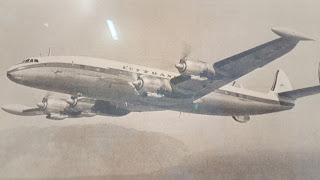They weren't exactly queuing up around the block to get in to the Whitechapel Gallery when I popped in to see Thomas Ruff's Photographs 1979-2017 the other Wednesday afternoon and if truth be told the sparse, apathetic attendance reflected a(n initially) somewhat sparse, somewhat apathetic show. A retrospective that I feared it would be hard not to rush round and one I was concerned would be equally difficult to come away from feeling particularly inspired by.
Which would've been a pity because these grey January days, my current reduced circumstances, and the thought of (hopefully) reaching my half-century later this year has left me feeling more than a little fed up and definitely in need of some inspiration. Show me nice things. Make me happy.
fotogramme (photograms) (2012-14)
Of course it's not Thomas Ruff's fault that I'm becoming a miserable git. He doesn't take his photographs for me. In fact looking at quite a large selection of them it would seem he doesn't take them for anyone else except himself. That's fine. I do the same. But mine aren't in a gallery - and they should be (well, some of them).
Born in Germany in 1958 Ruff studied at the Art Academy in Dusseldorf and has stayed on in the capital of North Rhine-Westphalia where he lives and works to this day. He's not what you'd call a snapper, preferring to work on projects, grand or otherwise, often consisting of a series of photographs taken over a period of months or even years. Between 1977 and 1985 he studied under Bernd and Hilla Becher (alongside Andreas Gursky, Candida Hofer, and Thomas Struth) but whereas the Becher's surveys of industrial architecture are one of the most singularly fascinating things in all art, Ruff either doesn't have the discipline (or simply gets bored more easily than the Bechers), to dedicate his practice to such a monomaniacal pursuit.
If Ruff could be said to have any one over riding theme it'd be photography itself. That's not meant to sound trite, plenty of painters have enthused, to levels of ardency that border on lunacy, about paint itself so there's no shame in making photography about photography. But it has to be good, has to engage, and Ruff's work only intermittently does that I'm afraid.
The Whitechapel have presented eighteen different series of Ruff's works dating from the late seventies right up to the present day. It doesn't help that the exhibition kicks off with one of the most self-indulgent, and least interesting, series of all. L'Empereur is remarkable only in that it's a rare example of self-portraiture from Ruff. He'd been awarded a grant to study at the Cite Internationale des Arts in Paris and lost for a subject (shouldn't he have had one before he was granted a grant?) he turned the camera on himself and struck some self-consciously wacky poses on a couple of leather seats. It reeks of 'will this do?' and it's quite surprising that from these embarrassingly weak beginnings he managed to progress on to make better work. It's even more surprising that there were people out there prepared to fund it. They must've seen something there that I still can't.
L'Empereur (The Emperor) (1982)
L'Empereur (The Emperor) (1982)
m.n.o.p. (2013)
The annoyingly titled m.n.o.p. and w.gl. series both look at emptiness and abstraction. In the former Ruff looks at Solomon R.Guggenheim's Museum of Non-Objective Painting (m.n.o.p.) in Manhattan and speculates on what the gallery would look like with nobody in it (something he could achieve by simply visiting his own exhibition) and all the walls painted in garish colours.
It's not the most interesting idea anyone's ever had and w.g.l. is only marginally more worthwhile. The concept here (and I guess the best way to view Ruff's work is through the prism of conceptualism) is that the architecture of the gallery becomes part of the exhibition. The Jackson Pollocks displayed on unvarnished breezeblocks look pretty cool but it's unclear how much credit we can give Ruff for simply observing this.
w.g.l. (2017)
w.g.l. (2017)
Portrats (Portraits) (1987-88)
Some I suppose - after all photography is as much, if not more, about seeing the picture with your eye than taking it with your camera. The late eighties series of portraits may focus on the reasonably young and reasonably trendy of Germany but Ruff was a young man himself at the time so it seems likely that he was merely taking photos of who, and what, was around him.
In 1929 August Sander created a taxonomy of 'people of the 20th century according to their job or social designation' which sounds very much like the sort of thing that was going down in the 20s and 30s in Germany (or that Toby Young would like to restart now) but, fortunately, Ruff's portraiture has a much lighter, less judgemental, touch. The young blonde lady (A.Kochold apparently, very formal) may stare out at us dispassionately but there is a humanity in these works that is lacking in Ruff's dry assessments of empty spaces. Edward Hopper could breathe life into an empty space, make you yearn for the lost souls who once occupied that space, but Ruff's emptiness is just that - empty - in so many senses of the word.
Portrats (Portraits) (1987-88)
Interieurs (Interiors) (1979-82)
In most cases anyway. Some of the Interieurs do nod towards Hopper's trick of showing you the space and letting you fill in the blanks. They assume in the viewer a basic intelligence and a reasonable imagination and they work much better because of that. The exhibition isn't layed out in chronological order but at times it feels like that as, for the most part, the work improves as you walk the three rooms spread over two floors. Perhaps we're just getting more comfortable in Ruff's company.
These quiet works, in places reminiscent of Memphis's William Eggleston, carry more power than Ruff's artsy tricks which seem to have been made to impress his art school friends rather than to make any form of connection with the viewing public. It's a testament to their strength that, exhibited opposite a photo of the Empire State Building with the smoke from Twin Towers encompassing it on 9/11, they hold their own.
Of course a photo of 9/11 is always going to be powerful and we've all seen lots of them. To the degree it's hard to imagine a different way of framing it. Ruff was in New York at the time and witnessed the event with his own eyes. He took photos on that day but none of them seemed to do the enormity of the subject justice so he turned to the Internet, nicked a few jpegs, and then enlarged them to such a degree that their pixelated composition became impossible to ignore. It seems like his way of saying that here is an event we have seen, and will continue to see, so many times that the original image in our mind has been replaced by repetitions and imaginings of the event.
jpeg ny01 (2004)
Haus Nr. 7 I (1988)
Haus Nr. 11 III (1990)
Further subversion of traditional ways of seeing can be observed in '87-'91s Houser and '99-2012s nudes series. The clear, neat modernist lines of Dusseldorf homes and factories sit in stark contrast to the blurred curves of the softly pornographic images of scantily clad young ladies. Houser mark Ruff's clearest debt to the Bechers and nudes is nothing like them whatsoever.
Both, however, are not what they seem. In Houser, Ruff has removed trees and traffic signs and has closed windows so that the image we see is the one he wants us to see, not the one we'd see if we were to walk past these buildings. nudes plays on how the early days of the internet suddenly made available a wealth of pornographic images but how the technological limitations of the age left those images pixelated in poor resolution. To further study this Ruff downloaded internet pornography under a vast array of categories and fantasies' which is an excuse he's been making for nearly two decades now!
nudes (1999-2002)
Maschinen (Machines) (2003)
Truth is:- both the images and the concept that underpins them look nearly as dated as his steampunk considerations of Maschinen that followed. Of course they're not really steampunk (steampunk purists would be irked at such a suggestion but no opportunity to irk a steampunk purist should ever be denied), they're just some isolated contraptions found gathering dust in a Dusseldorf factory, their anachronistic nature making them odd and therefore interesting. Rendering them in negative doesn't seem to particularly improve but it doesn't do them any harm.
fotogramme works better. Inspired by both Lazslo Moholy-Nagy and Man Ray and their pioneering techniques for making photographs without using a camera, Ruff has placed objects directly on to photosensitive paper and exposed them to light. As light falls over the objects their shadows appear on the paper creating delightfully ghostly patterns. They're probably the best things in the entire show and it's why one of them has been used as the header for this blog.
fotogramme (photograms) (2012-14)
negative (negatives) (2014-15)
negative (negatives) (2014-15)
negative (negatives) (2014-15)
The negative series is charming too. Ruff's made his negatives from positive prints (mirroring how this show develops:- the initial negativity slowly giving way to a positive appraisal of his work) of Indian princes, artists' studios, and still life compositions. Like the fotogramme series they have an uncanny charm that makes them pleasing to the eye.
The last two series (Zeitungsfotos from the early nineties and press++ from two years back) don't rely so much on photographic trickery but do still impress. They're concerned with how the news media presents images to us and how our view of hugely complex current affairs is distilled, distorted, and simplified by the editorial process. He's riffing on Marshall McLuhan's 'the medium is the message' basically, but he riffs well.
His archive of press cuttings appears to have been nearly as large as his archive of downloaded grot and Ruff even went as far as to collect archived material from German news agencies (the reason, one would assume, for all the stamps on them). He cropped them, scanned them, overlayed them, and made each image, as ever, absolutely his.
From weak beginnings the Thomas Ruff retrospective finally won me over. It may've been all about him and that's hardly what we need in these days of stark and rampant individualism but it was also all about photography, process, manipulation of images, and manipulation of media. By the end of it I wasn't sure if he'd manipulated me into thinking he was a great photographer or not. I left, as I arrived, confused.
Zeitungsfotos (Newspaper Photographs) (1990-91)
Zeitungsfotos (Newspaper Photographs) (1990-91)
press++ (2016)
press++ (2016)
press++ (2016)


























No comments:
Post a Comment